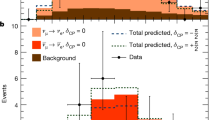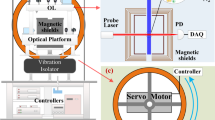Abstract
MOST current theories of particle symmetries assume that violations of these symmetries come about through a spontaneous breaking mechanism which produces non zero expectation values for certain scalar (elementary or composite) fields. As is well known (refs 1–7 and Lebedev Institute Reprint No. 101) these expectation values may make a phase transition to a zero value for certain critical temperatures and possibly also for certain critical external magnetic field strengths Hc, HC1, HC2,… Here we point out that it is conceivable that the charge asymmetry (associated with CP violation) in KL→π±+l±+ṽ(ν) decays may disappear for fields of ∼ 8 × 1010 gauss if CP violation is milli-weak in character, and that the Cabibbo angle may be reduced to zero—leading to suppression of certain hyperon decays—in fields of the order of 1016 gauss. These estimates are so strongly model-dependent that it may be worthwhile in any case, to make a systematic phenomenological search for effects on particle asymmetries of strong magnetic fields of 106 gauss upwards.
This is a preview of subscription content, access via your institution
Access options
Subscribe to this journal
Receive 51 print issues and online access
$199.00 per year
only $3.90 per issue
Buy this article
- Purchase on Springer Link
- Instant access to full article PDF
Prices may be subject to local taxes which are calculated during checkout
Similar content being viewed by others
References
Brout, R., Phase Transitions, 5 (Benjamin, New York, 1965).
Kirzhnits, D. A., Soviet Phys. JETP, 15, 745 (1972).
Kirzhnits, D. A., and Linde, A. D., Phys. Lett., 42 B, 471 (1972).
Weinberg, S., Phys. Rev. D., 9, 3357 (1974).
Dolan, L., and Jackiw, R., Phys. Rev. D., 9, 3320 (1974).
Bernard, C., Phys. Rev. D., 9, 3312 (1974).
Harrington, B. J., and Yildiz, A., Phys. Rev. Lett., 33, 324 (1974).
Saint James, D., Sarma, G., and Thomas, E. J., Type II Super-conductivity, 23 (Pergamon, Oxford, 1969).
Lee, T. D., Phys. Rep., 9 C, No. 2 (1974).
Pais, A., and Primack, J., Phys. Rev. D., 8, 3063 (1973).
Mohapatra, R. N., and Pati, J. C., Phys. Rev., D 8, 2317 (1973).
De Gennes, P. G., Superconductivity of Metals and Alloys (Benjamin, New York, 1966).
Author information
Authors and Affiliations
Rights and permissions
About this article
Cite this article
SALAM, A., STRATHDEE, J. Transition to CP conservation and zero Cabibbo angle in strong magnetic fields. Nature 252, 569–571 (1974). https://doi.org/10.1038/252569a0
Received:
Issue Date:
DOI: https://doi.org/10.1038/252569a0
This article is cited by
-
Phenomenology of magnetic black holes with electroweak-symmetric coronas
Journal of High Energy Physics (2020)
-
Symmetry structure and phase transitions
Pramana (2003)
-
Production of unstable nuclei far from the stability line: its scope and limitations
Hyperfine Interactions (1993)
-
Dynamical symmetry breaking due to vacuum misalignment
Zeitschrift für Physik C: Particles and Fields (1990)
-
Phase transition in gauge theories
Pramana (1985)
Comments
By submitting a comment you agree to abide by our Terms and Community Guidelines. If you find something abusive or that does not comply with our terms or guidelines please flag it as inappropriate.



